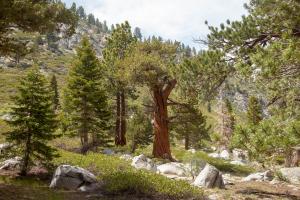 Trail proponents in Mammoth Lakes recently asked the Forest Service to approve the development of 15 miles of new multi-use trails in two locations: several short segments in the Mammoth Lakes Basin and one long segment from Solitude Canyon over the Sherwin Crest and down to the Mammoth Lakes Basin. The trails would be geared primarily to extreme mountain bikers, trail runners and others. These trails would connect to other trails and allow one to circumnavigate the Town of Mammoth Lakes--a dream come true for some, but a nightmare for wildlife and a degradation of the environment.
Trail proponents in Mammoth Lakes recently asked the Forest Service to approve the development of 15 miles of new multi-use trails in two locations: several short segments in the Mammoth Lakes Basin and one long segment from Solitude Canyon over the Sherwin Crest and down to the Mammoth Lakes Basin. The trails would be geared primarily to extreme mountain bikers, trail runners and others. These trails would connect to other trails and allow one to circumnavigate the Town of Mammoth Lakes--a dream come true for some, but a nightmare for wildlife and a degradation of the environment.
On June 8, the Inyo National Forest issued a brief, 2.5 page scoping notice and proposed to issue a categorical exclusion under the National Environmental Policy Act (NEPA) for this project. The scoping document included a map of the trails, but no description. The next step is a final decision from the District Ranger with a short summary of the environmental impacts and required mitigations. With a categorical exclusion, there will be no environmental assessment (EA) or environmental impact statement (EIS), no analysis of alternatives, nor an opportunity for the public to challenge or augment the information that the decision will be based on.
However, our public lands are too valuable for this project to be a slam-dunk. At least 12 of those 15 miles of new trail would be in the pristine Sherwin Inventoried Roadless Area that has wilderness qualities and little or no human disturbance. Solitude Canyon is a critical migration corridor for the largest mule deer herd in the central Eastern Sierra. Mule deer use this corridor during their spring and fall migrations to reach the high Sierra meadows. Some deer birth their fawns and spend the summer in the canyon. The trail would cut through an incredibly diverse old-growth conifer forest with Jeffrey pine, western white pine, whitebark pine, red and white fir, lodgepole pine, Sierra juniper, and mountain hemlock. It is unusual to see stands of western white pine that are found here. There’s aspen and willow in the talus areas. There’s limber pine on the crest. Pikas live in the rock jumbles. There is a potential for the Sierra Nevada Red Fox, a candidate endangered species, to use this habitat. None of this was described in the scoping document. The public was just given a line on a map. Those who commented had to do their own research and/or hike the proposed Solitude Canyon trail route to get an idea of what would be impacted by a trail and what would be sacrificed.
Local community members helped design the short trail segments being proposed in the Mammoth Lakes Basin, but not the controversial trail through Solitude Canyon. It would primarily serve mountain bikers, hardy hikers and runners in training, perhaps. It is too steep and rocky for equestrians and certainly would not be safe to share with bikers. For the sake of still more recreational development in Mammoth, this new trail would push out wildlife in the only migration corridor open to them. Marketing of this trail will finalize the conversion of habitat at a time when the loss of wildlife habitat is unprecedented and there are calls to preserve 30% of nature.
The proposal is being framed as a “locals” issue, but it is not just up to the locals to decide how our public lands are used. All citizens should help shape this decision and many would have a much broader view than the Town of Mammoth Lakes’. That is exactly why there is an environmental analysis process in the National Environmental Policy Act requiring an EA or an EIS and fair consideration of a range of alternatives including “No Action”. It is to make sure decisions are made on the best available science and that many perspectives are taken into consideration. The Sierra Club and several environmental groups signed on to the Friends of Inyo comment letter requesting an EA. This project does not qualify for a categorical exclusion.